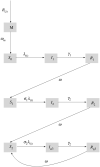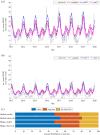The influence of demographic and meteorological factors on temporal patterns of rotavirus infection in Dhaka, Bangladesh
- PMID: 35673869
- PMCID: PMC9174722
- DOI: 10.1098/rspb.2021.2727
The influence of demographic and meteorological factors on temporal patterns of rotavirus infection in Dhaka, Bangladesh
Abstract
To quantify the potential impact of rotavirus vaccines and identify strategies to improve vaccine performance in Bangladesh, a better understanding of the drivers of pre-vaccination rotavirus patterns is required. We developed and fitted mathematical models to 23 years (1990-2012) of weekly rotavirus surveillance data from Dhaka with and without incorporating long-term and seasonal variation in the birth rate and meteorological factors. We performed external model validation using data between 2013 and 2019 from the regions of Dhaka and Matlab. The models showed good agreement with the observed age distribution of rotavirus cases and captured the observed shift in seasonal patterns of rotavirus hospitalizations from biannual to annual peaks. The declining long-term trend in the birth rate in Bangladesh was the key driver of the observed shift from biannual to annual winter rotavirus patterns. Meteorological indices were also important: a 1°C, 1% and 1 mm increase in diurnal temperature range, surface water presence and degree of wetness were associated with a 19%, 3.9% and 0.6% increase in the transmission rate, respectively. The model demonstrated reasonable predictions for both Dhaka and Matlab, and can be used to evaluate the impact of rotavirus vaccination in Bangladesh against changing patterns of disease incidence.
Keywords: birth rate; demography; meteorological factors; rotavirus seasonality; rotavirus transmission.
Conflict of interest statement
V.E.P. has received reimbursement from Merck and Pfizer for travel expenses to attend a Scientific Input Engagements unrelated to rotavirus vaccines and is a member of the WHO Immunization and Vaccine-related Implementation Research Advisory Committee (IVIR-AC).
Figures





References
Publication types
MeSH terms
Substances
Grants and funding
LinkOut - more resources
Full Text Sources
Medical

